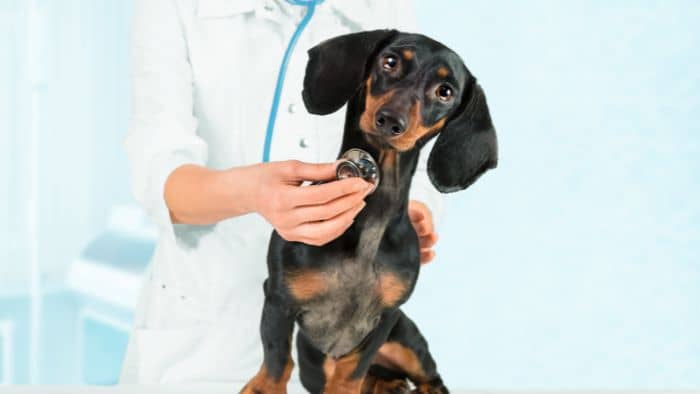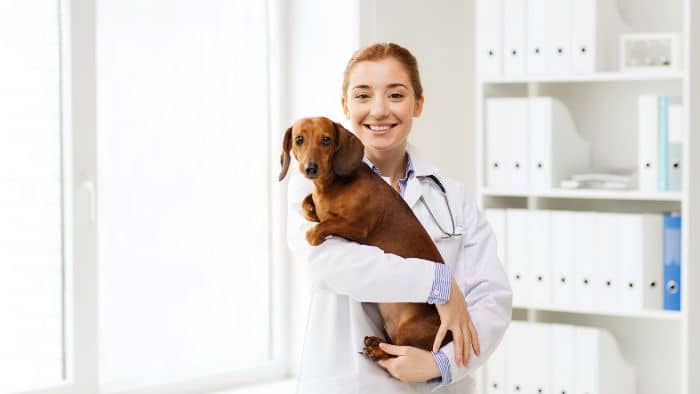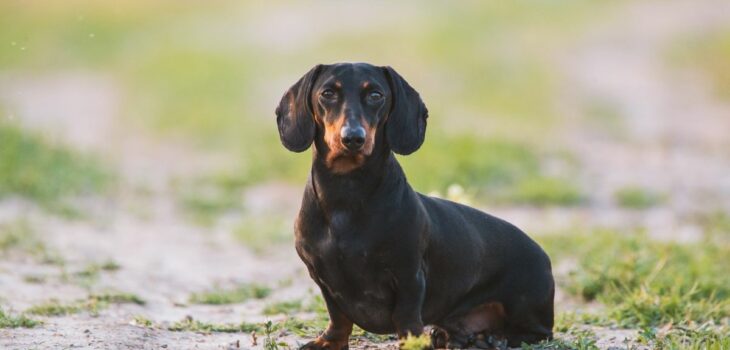How concerned should you be if you find a dachshund lump on chest or ribcage? Does a lump on your dachshund’s chest indicate that it could be cancer, or is there a more innocent explanation? Let’s find out!
Why Does My Dog Have A Lump On His Rib Cage?
If you find that your dog has a lump on his rib cage or chest area, the most important thing to remember is not to panic! Although you were most likely concerned that it could be a cancerous tumor, there are also many innocent explanations why you might find a lump on your dachshund’s chest.
A lump or bump that appears suddenly could be something as innocent as an insect sting or inflamed hair follicle. Slow growing lumps in older dogs may just be a benign tumor that will not cause any problems.
However, it is not always easy to tell if a lump is a serious problem or not! If you are ever in any doubt, it is a good idea to take your dog to the veterinary clinic to be assessed. Even if the lump turns out to not be a problem, this will not have been a waste of time as your mind will have been set at ease.
When Should I Worry About Lumps On My Dog?
If you find a lump or bump on your dog, is a good idea to assess it carefully to see if it needs checking out by your veterinarian. Lumps that appear quickly or that are painful when touched warrant a veterinary examination to rule out potentially serious problems.
If a lump seems to be growing very slowly and is not painful to touch, you can monitor it for a few days or even weeks to see how it progresses. It is a good idea to make notes of the size and shape of the lump, and also take photographs so you can see if it is growing or not.

How Can You Tell If A Lump On A Dog Is Cancerous?
If your veterinarian suspects that a lump on your dog is cancerous, they will carry out some simple tests to to determine exactly what it is.
A fine needle aspirate is a test that is relatively simple to perform and only causes minor discomfort to your dog. A needle is inserted into the lump and a syringe is used to draw out a sample of cells from inside the tissue. These cells are then examined under a microscope to try and identify the type of lump your dog has.
If this test is not conclusive, your veterinarian may want to take a biopsy of the lump. This is a minor surgical procedure where a sample of the tissue inside the lump is cut out and sent to a laboratory. The lump will then be analyzed and the laboratory will be able to advise you on whether it is cancerous or not.
Are Cancer Lumps In Dogs Hard Or Soft?
Dogs can get many different types of cancerous lumps, and they come in all sorts of shapes and sizes. Skin tumors are one of the most common types of cancer in dogs, and many dogs have benign tumors that do not cause a problem. However, malignant tumors can spread to other areas of the body and internal organs, so it is useful to know what type of tumor your dog has.
One of the best ways to check whether a tumor is malignant or benign is to feel whether it is smooth or knobbly. The most common benign skin tumor of dogs is a lipoma, which is a smooth, fatty lump. These commonly sit within the skin surface and are not attached to the tissues underneath.

Lipomas are very common in older dogs such as dachshunds. Many dogs will have several lipomas over different areas of the body. They grow slowly over a long period of time and do not normally cause a problem unless they become ulcerated or rub against another body part.
Malignant tumors tend to be harder with a knobbly surface. They may be adhered to the surface underneath the skin, particularly over the rib cage. Malignant tumors commonly develop a sore or ulcerated surface and may grow rapidly over several areas of the body.
Dachshund Lump On Chest Treatment Options
If your dog has a lump on its chest, your veterinarian will first of all try to discover what type of lump it is. Benign tumors are not normally removed unless they are ulcerated or causing you dog discomfort. It is good idea to monitor the size and rate of growth of any lump to help determine whether it needs to be removed or not.
Malignant tumors may need more aggressive treatments and are often removed before they spread to other body parts. If the tumors have spread to internal body organs, your dog may also need treatments such as chemotherapy or radiotherapy. These can be very debilitating for your dog and many pet owners prefer to provide palliative supportive care instead.
Summary – Dachshund Lump On Chest
So, as we have learned, finding a lump on your dachshunds chest or rib cage is not always a reason to panic or worry. Many lumps are caused by simple problems such as insect bites or inflamed hair follicles and are not tumors at all. Cancerous lumps in older dogs may be benign tumors that do not cause a problem. In rare cases, your dog may develop a malignant tumor on its chest, which will need veterinary treatment.
We’d love to hear your thoughts on the possible causes and treatments for a dachshund lump on chest! Perhaps you found a lump on your dachshund and are not sure whether to get it checked out by the veterinarian or not? Or maybe you’ve got some questions about the aftercare for a dog that has had a lump removed from its chest? Leave a comment below and we will get back to you!




